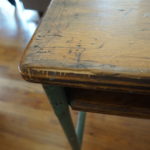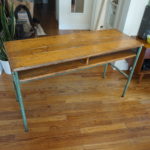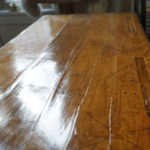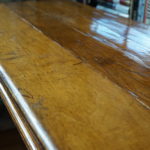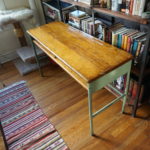So, this wondrous piece of historical beauty was actually the impetus for investing in a storage unit. I saw it on Craigslist and knew that I absolutely had to get it, but had no where for it. I pleaded and pitched until finally my wonderful other half agreed that we could get a storage unit. Promptly we rushed out to nab this old desk.
It seems to have a pretty solid provenance–manufactured sometime in the 20s or 30s by the Doehler Metal Furniture Company in Manhattan and used at a Catholic school in Brooklyn until it shut down. At some point, it experienced some water damage, which caused the top ply of the plywood to split and peel up. Previous owners had attempted to mitigate this by stapling down the edges, to little avail.
I was absolutely adamant that anything I do to refinish this piece would not affect the decades of accumulated scratches, scuffs, stains and should-have-been-ephemera. Given its origin, you could almost audibly hear this desk saying “I mean, you want character? Fuhgedaboutit!”
With the extent of water damage, and how much of the top ply had peeled up, I initially thought I would be able to strip off the top ply in large pieces, flatten each piece through sheer force of will and power, and then glue each piece back into place. So, that’s where I started.
Unfortunately, only a few large pieces came off readily. I made some light attempts to coax off the rest of it, but stopped for fear of ruining the top and losing all the character. Caught halfway through my repair scheme, I found myself stuck with something of a mess of wood bits, no closer to actually fixing the damage. After a moment or two of despair, fueled by the certainty that I had forever ruined a thing of such antiquated beauty, I steeled my resolve and broke out the ratchet straps.
Using some heavy-duty glue, I started the painstakingly-slow process of rubbing glue under the peeled edges of the pieces that I couldn’t remove, and then holding them in place with ratchet straps cranked down as tight as I could possibly get them. Now, this possibly could have gone much faster if the table were, itself, somewhat level. But, of course it is not, so I could only work in small areas at a time, otherwise the straps could not ratchet down tight enough to hold the wood ply in place.
After moving through this process with the pieces that wouldn’t come off, I proceeded with the pieces that had, moving at an equally slow pace, with equally slow results. All-in-all, it took me about two weeks to get all the wood glued down. While the results weren’t close to perfect, it was much better than it had been. And, best of all, I hadn’t ruined anything.
Wanting to make sure that the wood wouldn’t dry out and split again, I applied half a quart of shellac, in over a dozen individual coats, to fill and seal all the splits and cracks and spots where the wood couldn’t be entirely flattened. It also sealed in all the beautiful bits of glitter and graffiti that added so much charm to the desk; and gave it a wonderful, smooth, hand-rubbed feel.


